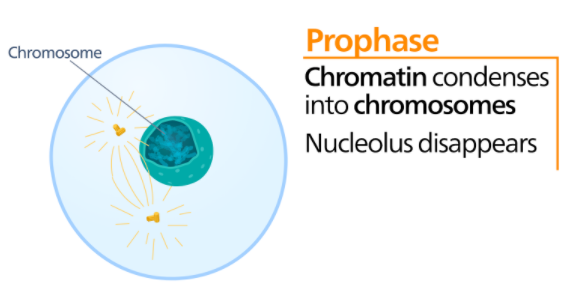
What is known as condensation of chromosomes?
Answer
399k+ views
Hint: A chromosome is defined as a string of DNA wrapped around associated proteins that give the connected nucleic acid bases a structure and it carries a part of genetic information. Chromosome condensation is the reorganisation of chromatin strands into short chromosomes.
Complete answer:
Chromosome condensation basically explained as one of the major chromatin-remodelling events that occur during Prophase I. It is the longest phase of meiosis where;
- Chromatin condenses into chromosomes.
- The physical contact between homologous chromosomes happens
- The transmission of genetic information between synapsed chromosomes.
Here is an outlook of the condensation of chromosomes.

There are five sub-phases under prophase
i) Leptotene: The condensation of chromosomes starts and they attach to the cell membrane through telomeres.
ii) Zygotene: Here pairing of chromosomes starts in this stage and synapsis between homologous chromosomes begin. The paired chromosomes are named bivalents.
iii) Pachytene: Here a chromatid of one pair starts attaching to the chromatid in a homologous chromosome hence the synapse is formed and the crossing over begins. After some time, the crossing over of genetic material between the non-sister chromatids occurs in this phase.
iv) Diplotene: Here, the paired chromosomes separate and become into two pairs of chromatids.
Diakinesis: The chromosomes are highly condensed in this phase. Here the nuclear membrane disintegrates, the nucleolus vanishes and the centrioles move to the equator.
Note: Significance of meiosis is as follows;
- It is responsible for the formation of gametes without which sexual reproduction cannot happen.
- The genetic information for the development of gametes is activated by meiosis and also deactivates the sporophytic information.
- Chromosome numbers are maintained properly by halving the same as the chromosome number doubles after fertilization.
Complete answer:
Chromosome condensation basically explained as one of the major chromatin-remodelling events that occur during Prophase I. It is the longest phase of meiosis where;
- Chromatin condenses into chromosomes.
- The physical contact between homologous chromosomes happens
- The transmission of genetic information between synapsed chromosomes.
Here is an outlook of the condensation of chromosomes.

There are five sub-phases under prophase
i) Leptotene: The condensation of chromosomes starts and they attach to the cell membrane through telomeres.
ii) Zygotene: Here pairing of chromosomes starts in this stage and synapsis between homologous chromosomes begin. The paired chromosomes are named bivalents.
iii) Pachytene: Here a chromatid of one pair starts attaching to the chromatid in a homologous chromosome hence the synapse is formed and the crossing over begins. After some time, the crossing over of genetic material between the non-sister chromatids occurs in this phase.
iv) Diplotene: Here, the paired chromosomes separate and become into two pairs of chromatids.
Diakinesis: The chromosomes are highly condensed in this phase. Here the nuclear membrane disintegrates, the nucleolus vanishes and the centrioles move to the equator.
Note: Significance of meiosis is as follows;
- It is responsible for the formation of gametes without which sexual reproduction cannot happen.
- The genetic information for the development of gametes is activated by meiosis and also deactivates the sporophytic information.
- Chromosome numbers are maintained properly by halving the same as the chromosome number doubles after fertilization.
Recently Updated Pages
Master Class 11 Accountancy: Engaging Questions & Answers for Success

Glucose when reduced with HI and red Phosphorus gives class 11 chemistry CBSE

The highest possible oxidation states of Uranium and class 11 chemistry CBSE

Find the value of x if the mode of the following data class 11 maths CBSE

Which of the following can be used in the Friedel Crafts class 11 chemistry CBSE

A sphere of mass 40 kg is attracted by a second sphere class 11 physics CBSE

Trending doubts
Define least count of vernier callipers How do you class 11 physics CBSE

The combining capacity of an element is known as i class 11 chemistry CBSE

Proton was discovered by A Thomson B Rutherford C Chadwick class 11 chemistry CBSE

Find the image of the point 38 about the line x+3y class 11 maths CBSE

Can anyone list 10 advantages and disadvantages of friction

Distinguish between Mitosis and Meiosis class 11 biology CBSE




